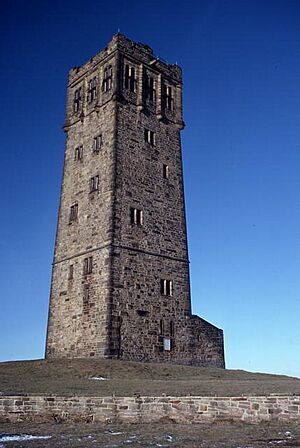Castle Hill, Huddersfield facts for kids
Castle Hill is a famous landmark near Huddersfield in West Yorkshire, England. It's a very old place, used by people for at least 4,000 years! This hilltop has the remains of ancient forts from the Bronze Age and Iron Age. There are also signs of a 12th-century motte-and-bailey castle and a village that was abandoned long ago.
The most noticeable building on Castle Hill is the Victoria Tower. It's a historic building and a well-known sight in Huddersfield. For hundreds of years, people have come to the hill for fun. The old remains here have led to many stories and studies. You can find Castle Hill on maps at grid reference SE152140.
Contents
How Castle Hill Was Formed
Castle Hill looks the way it does because of its rocks. A hard layer of sandstone on top protected the softer rocks below from wearing away. The sides of the hill are made of different layers. These layers include shale and other types of sandstone.
There are also five layers of coal hidden in the lower parts of the hill. Some of these coal layers have been mined in the past. You can still see signs of old mines and quarries in several spots.
A Look at Castle Hill's Past
Ancient Times on the Hill
The very first people to visit Castle Hill were probably hunters. They lived here during the Mesolithic age, camping in the thick forests. Later, in the Neolithic and Bronze Age, people traveled widely. They traded tools made of stone and bronze across different regions.
Around 555 BC, during the early Iron Age, a large fort was built on the hilltop. Its defenses were improved around 43 AD. This was likely to protect against the arriving Roman invaders.
Archaeologists dug up parts of the fort in 1970. They found that Castle Hill had once suffered a big fire. Forts that show signs of being burned so hot that their stones melt are rare in England. They are more common in Scotland.
The banks and ditches you see today are probably from the Middle Ages. They have also changed over hundreds of years due to weather.
The Norman Castle and Village
After the Norman Conquest in 1066, Almondbury became part of a large area owned by the de Laci family. They built a small castle on Castle Hill. Records from King Stephen, dating between 1142 and 1154, mention this castle.
Archaeologists found a wooden stake from the 1140s and a coin from about 1160. This suggests the castle was finished and used by the 1140s.
In the early 1300s, people tried to start a village on the hill. Old maps show a main road with plots of land laid out. This village was probably abandoned by the 1340s. However, people remembered it, as a 1634 map still marked the hill as a town site.
After the Middle Ages, Castle Hill was empty until the early 1800s. Its high position made it perfect for a warning beacon. It was part of a network of beacons across the country.
Castle Hill in Modern Times
Castle Hill's flat top was a popular spot for big meetings. Political groups, like the Chartists, held rallies here in the 1840s. In 1883, during a big weavers' strike, thousands of people gathered despite bad weather.
Around 1810, a tavern (a type of pub) was built on the hill for visitors. There was also a bowling green nearby. Other activities like bare-knuckle fights and animal fights also took place here.
A company bought the pub and wanted to fix it up. However, they didn't follow the rules for building. The pub was later taken down. Plans to rebuild it have not been approved.
During the Second World War, an anti-aircraft gun battery was built on the hill. This was to shoot down enemy planes. You can still see parts of these old defenses today. Sometimes, pieces of old shell casings are found in nearby fields.
Today, Castle Hill still shows signs of all its past uses. It's a favorite place for local people and tourists. In 2006, power lines were buried underground. This made it safer for people to fly kites on the windy hilltop.
The Victoria Tower
By 1897, Queen Victoria had been queen for sixty years. This was longer than any other British ruler. People wanted to build a lasting memorial to this event. They decided on a tower on Castle Hill, overlooking Huddersfield.
Even though it was hard to raise enough money, the tower opened on June 24, 1899. It was opened by the Earl of Scarborough. Many people call it the Jubilee Tower, but its real name is the Victoria Tower.
Isaac Jones of London designed the tower. It was built by Ben Graham and Sons, using stone from Crosland Hill. It cost £3,298. The tower is 106 feet (32.3 meters) tall. With the hill's height, the very top is 1,000 feet (305 meters) above sea level.
During the Second World War, some people thought the tower should be torn down. They worried it could help German bombers find their way. A few bombs were dropped near the tower in 1940 and 1941. However, these were probably just dropped randomly.
The Victoria Tower is a Grade II Listed Building, meaning it's an important historic structure.



